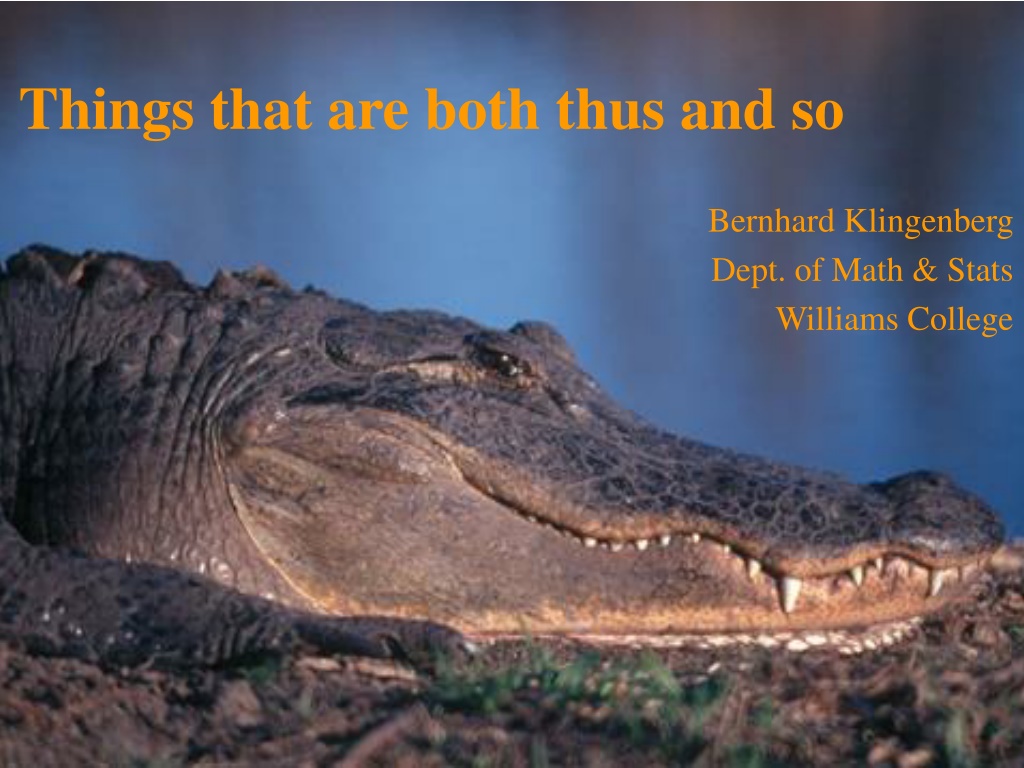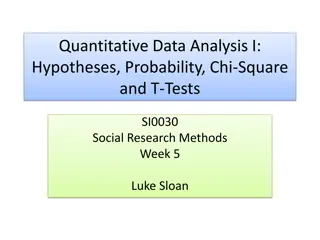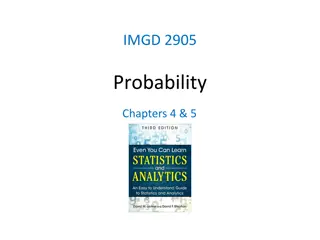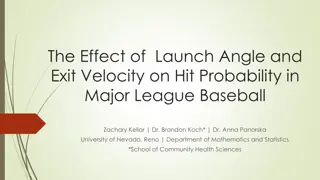Exploring Association and Probability in Statistical Analysis
Early statistical concepts from the works of M. H. Doolittle and Sir Ronald Fisher are discussed in this academic content, focusing on analyzing associations and applying probability distributions. The content covers the responsibility of partners in ensuring safer sex, constructing 2x2 tables, and utilizing Fisher's Exact Test to evaluate Dr. Bristol's ability. Various tables and examples elucidate the concepts of association and probability in statistics.
Download Presentation

Please find below an Image/Link to download the presentation.
The content on the website is provided AS IS for your information and personal use only. It may not be sold, licensed, or shared on other websites without obtaining consent from the author. Download presentation by click this link. If you encounter any issues during the download, it is possible that the publisher has removed the file from their server.
E N D
Presentation Transcript
Family Weekend 2006 Things that are both thus and so Bernhard Klingenberg Dept. of Math & Stats Williams College Stat Lite: Great Taste Less Filling! Bernhard Klingenberg Dept. of Mathematics and Statistics Williams College
Q: Do you think your partner is responsible to ask about safer sex? (Yes, No) 1 1 1 1 A. Yes & Female B. No & Female C. Yes & Male D. No & Male 1 2 3 4
Result: 2 x2 Table Yes No Female Male Notation: Contingency or Cross-classification Table Goal: Summarize and describe association
Early Attempts on Describing Association Having given the number of instances respectively in which things are both thus and so, in which they are thus but not so, in which they are so but not thus and in which they are neither thus nor so, it is required to eliminate the general quantitative relativity inhering in the mere thingness of the things, and to determine the special quantitative relativity subsisting between the thusness and the soness of the things. M. H. Doolittle (1887), cited in Goodman and Kruskal (1979)
Several Ways of Obtaining 2 x 2 Table A B A B I I II II n A B A B n1 I I n2 II II m1 m2
One More Option: Fishers Exact Test Guess Milk A Tea B Milk I n1 4 1 3 Truth Tea II n2 4 3 1 Sir Ronald Fisher (1890-1962) m1 4 m2 4 n 8 Do these data provide evidence that Dr. Bristol has the ability to distinguish what was poured first?
All possible tables Truth Milk 1 . Truth Milk 0 . Truth Milk 2 . Guess Tea . Total Guess Tea . Total Guess Tea . Total 4 4 4 Milk Milk Milk . 4 . 4 . 4 Tea Tea Tea Total 4 4 8 Total 4 4 8 Total 4 4 8 Truth Milk 3 . Truth Milk 4 . Guess Tea . Total Guess Tea . Total 4 4 Milk Milk . 4 . 4 Tea Tea Total 4 4 8 Total 4 4 8
Probability Distribution? # correct guesses 0 # instances (out of 70) 1 Probability assuming we are just guessing and have no ability to distinguish 1 / 70 = 0.014 1 16 16 / 70 = 0.229 2 36 36 / 70 = 0.514 3 16 16 / 70 = 0.229 4 1 1 / 70 = 0.014 1 70 Fact: The number of correct guesses follows the hypergeometric distribution
Convinced? Chances of obtaining a high number of correct guesses by simply guessing must be small Here, only the case where one gets 4 correct guesses is convincing If you just randomly guessed, you get 4 correct 14 times out of a 100. That s rather unlikely (but not impossible), so it does give some credibility to your claim.
P-value for Fishers Exact Test What is the P-value for testing independence? How likely is it to observe the table we have observed, or a more extreme one, given there is no association (i.e., one is just guessing). How do we measure extremeness? Several options: Based on table null probabilities (the smaller (!), the more evidence for an association) Based on tables that result in first cell count (or odds ratio) as large or larger than observed (only for 2x2 tables) Based on Chi-square statistic (the larger, the more evidence for the alternative)
P-value for Fishers Exact Test Using table null probabilities as criterion: = P value table null prob. where the sum is over all tables that have null probability as small or smaller than observed table. Milk vs. Tea: H0: no association (independence) vs. HA: a positive association P-value = 0.014 if we observed 4 correct guesses P-value = 0.014 + 0.229 = 0.243 if we observed 3 correct guesses
Fishers Exact Test The procedure we just went through is called Fisher s Exact Test (1935) and has applications in Genetics, Biology, Medicine, Agri- culture, Psychology, Business, Sir Ronald Fisher (1890-1962)
Class Experiment Truth Diet Zero Diet 5 Guess Zero 5 5 5 10
How many correct guesses? Out of 10 cups: 5 with Diet, 5 with Zero # correct guesses 0 1 2 3 4 5 # instances (out of 252) 1 25 100 100 25 1 252 Probability 1 / 252 = 0.0040 25 / 252 = 0.0992 100 / 252 = 0.3968 100 / 252 = 0.3968 25 / 252 = 0.0992 1/252 = 0.0040 1
Fishers Exact Test Round 1: Fisher vs. Barnard Barnard (1945,1947): Fishers Exact Test too restrictive. Only fix row margins. The fact that such an unhelpful outcome as these might occur [ ] is surely no reason for enhancing our judgment of significance in cases where it has not occurred. (Fisher, 1945) Barnard (1915-2002) Fisher Barnard, in 1949, retracted his proposal in favor of Fisher s. Today: Still undecided, but generally Barnard s approach is preferred. (There is also a nice compromise: mid P-values) In any case: Prefer confidence intervals to P-values
Back to Describing Association Several Measures for Association: Difference of Proportion: (y1/n1) (y2/n2) Ratio of Proportion: (y1/n1) / (y2/n2) Odds Ratio: [ (y1/n1) / ( 1 - y1/n1) ] / [ (y2/n2) / (1 - y2/n2 ) ] M V F y1 M y2 n1 n2
Describing Association Round 2: Pearson vs. Yule Yule proposed the Odds Ratio to measure association in 2x2 tables Pearson, who had previously invented the correlation coefficient (r) for quantitative data proposed a similar measure for 2x2 tables: Tetrachoric Correlation Karl Pearson (1857 1936) Udyn Yule (1871 1951)
Describing Association Round 2: Pearson vs. Yule Yule sreaction to Pearson s suggestion: At best the normal coefficient can only be said to give us in cases like these a hypothetical correlation between supposititious variables. The introduction of needless and unverifiable hypotheses does not appear to me to be desirable proceeding in scientific work. Udyn Yule (1871 1951)
Describing Association Pearson continues: We regret having to draw attention to the manner in which Mr Yule has gone astray at every stage in his treatment of association [He needs to withdraw his ideas] if he wishes to maintain any reputation as a statistician. Today: Odds Ratio predominant measure, especially in clinical trials. Drawback: Hard to interpret.
Describing Association Round 3: Pearson vs. Fisher In 1900, Pearson introduced the Chi-square test for independence He claimed that for 2x2 tables the degrees of freedom for the test should be df=3. Fisher (1922) showed that instead they should be df=1.
Describing Association Round 3: Pearson vs. Fisher Pearson was not amused:
Describing Association Round 3: Pearson vs. Fisher Fisher was unable to get his reply published and later wrote: [My 1922 paper] had to find its way to publication past critics who, in the first place, could not believe that Pearson s work stood in need of correction, and who, if this had to be admitted, were sure that they themselves had corrected it.
Describing Association Round 3: Pearson vs. Fisher And about Pearson: If peevish intolerance of free opinion in others is a sign of senility, it is one which he had developed at an early age. Today: The df for the Chi-Squared test in 2x2 tables are 1, and more generally for IxJ tables, df=(I-1)(J-1)
Describing Association Knockout: Pearson vs. Fisher In 1926, Fisher analyzed 11,688 2x2 tables generated by Pearson s son (Egon Pearson) under the assumption of independence Fact: If independence holds, the value of the Chi-square statistic should be close to the df. Egon Pearson (1895 1980) Fisher showed that the mean of the Chi-square statistic for these tables is 1.00001
Research today Several 2x2 tables:
Research today Suppose you are measuring two binary features on the same subject (i.e., whether or not a patient experiences Abdominal Pain or Headache) Do this in two groups (i.e., Treatment vs. Control). Interested if the (marginal) probability of Pain and of Headache differs between the two groups. Group 1 Headache Group 2 Headache No Yes No Yes No No Pain Pain Yes Yes























